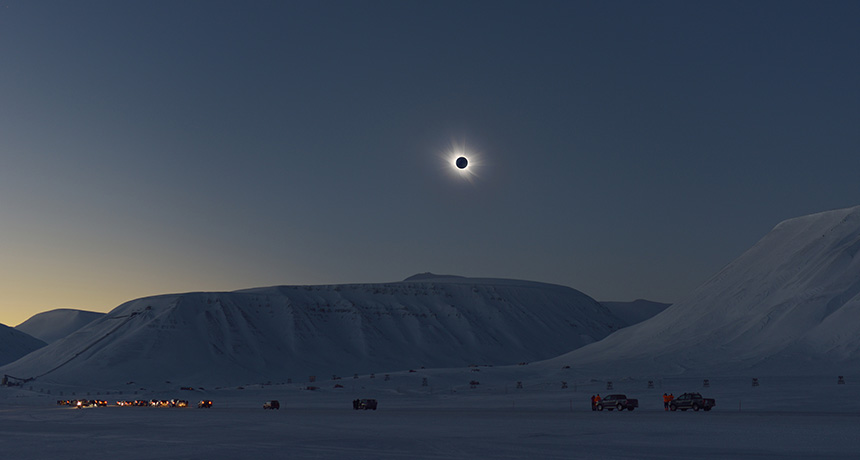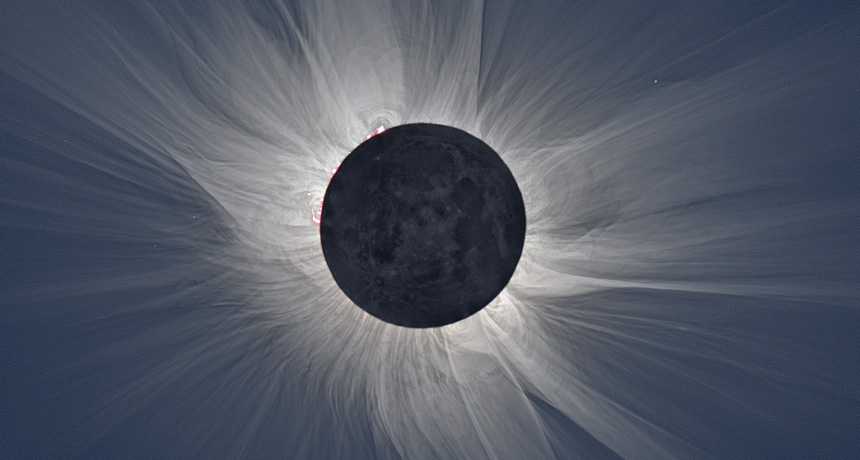
NIGHT AND DAY Solar physicists gained new insight into the origins of coronal mass ejections as they watched the 2015 solar eclipse darken the sky above Svalbard, Norway.
© 2015 Miloslav Druckmüller, Shadia Habbal, Peter Aniol, Pavel Štarha
- More than 2 years ago
For the first time, researchers have watched relatively cool parcels of plasma speed away from the surface of the sun and off into space, all the while cocooned in a million-degree flare.
Shadia Habbal of the University of Hawaii in Honolulu and colleagues used a specially designed spectrometer to observe the eruption from Svalbard, Norway, during the March 2015 solar eclipse. The results, published online June 9 in Astrophysical Journal Letters, include measurements of the speed, temperature and composition of filaments of solar material streaming away from the sun — three features never measured simultaneously before.
The data provide the first direct evidence of cooler solar material within an eruption and map its speed and trajectory, says Enrico Landi of the University of Michigan in Ann Arbor. “No instrument has ever been able to obtain these data.”
The sun’s surface is a roiling mass of hot ionized gas, or plasma, which is about a roasty 6,000° Celsius. But its corona, the wispy, halolike atmosphere that is visible during a solar eclipse, is superheated to millions of degrees. Scientists are still not sure how it gets so hot.
Story continues after image

Every so often, a huge, hot bubble of coronal plasma appears to burst off the sun’s surface in an eruption called a coronal mass ejection, or CME. These ejections send energetic charged particles hurtling into space at millions of miles per hour. When aimed at Earth, those particles can damage satellites and knock out power systems (SN Online: 4/9/12), so scientists want to understand CMEs to better predict them.
The trouble is, it’s difficult to watch CMEs close to their origins. Sun-watching spacecraft block out the bulk of the sun’s light with a shield to avoid blinding their cameras. That gives spacecraft a constant view of the shimmering corona, but hides the sun’s surface.
The March 20, 2015, total solar eclipse over Svalbard gave Habbal’s team a rare view of the whole solar atmosphere because the moon and the sun appear almost the same size in the sky. “You can see things right from the solar surface out to several solar radii,” she says.
Her team brought a custom-built spectrometer the size of an airline-approved carry-on, designed by coauthor Adalbert Ding of the Technical University of Berlin. The spectrometer is sensitive to wavelengths of light emitted by iron atoms that have lost all but 11 or 14 of their electrons. Researchers can use those iron ions in the solar material to trace temperature: The hotter the solar plasma, the more electrons the iron has lost.
Story continues after video
DARKNESS FALLS Shadia Habbal and colleagues watched from Svalbard, Norway in 2015 as an eclipse darkened the sky. It was a rare chance to see how the sun’s surface interacts with its atmosphere. SOHO, ESA, NASA |
As expected, coronal temperatures soared to 2 million or so degrees Celsius. But the team also saw some cooler blobs at a mere 20,000° C. Instead of losing their electrons to the heat and becoming ionized, these blobs maintained their cool.
Habbal thinks these are bright fingers of plasma called prominences, which had previously been observed stretching away from the sun before a CME.
“If you have an ice cube in a hot bath, it’s going to melt and evaporate,” Habbal says. “Here you have clusters of cool material that are enwrapped by very hot material. You would expect them to get ionized, but they didn’t.”
By measuring the solar material’s Doppler shift, or the change in wavelength as the material moved, the instrument could also clock its speed and direction. If the wavelength of the light appeared longer (or redder) in some places, that means the material was moving away from the observers. Shorter wavelength, or bluer light, indicated material moving toward them.
During the eclipse, material around the solar disk zoomed away at 100 to 1,500 kilometers per second. Such great speeds indicated that a CME erupted, and the direction suggested it was on the far side of the sun. Catching a CME during the short eclipse was a lucky coincidence.
“Lots of things about this experiment were just sheer luck,” Habbal says.
Cool inclusions have been spotted inside the hot corona before, but this is the first time they were seen fleeing the surface of the sun during a CME, Habbal says.
Prominences are thought to be associated with CMEs, and might even trigger their eruptions, but no one is sure how. Now that it’s possible to trace them from the solar surface out into space, researchers hope to spot more during the total eclipse as it crosses the United States in August (SN: 8/20/16, p. 14).
“If successful, it will be the dataset of a lifetime,” says Landi.
Editor’s note: This story was updated July 3, 2017, to include a reference to Habbal’s coauthor, and June 19, 2017, to correct a typo. Coronal temperatures were measured at about 2 million degrees Celsius, not billion.







